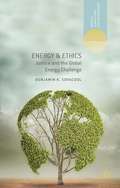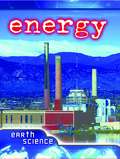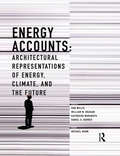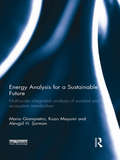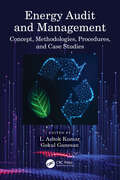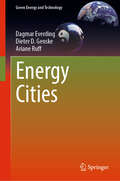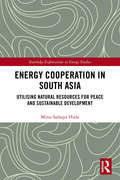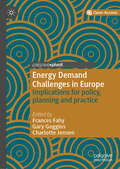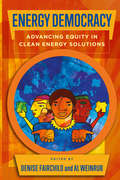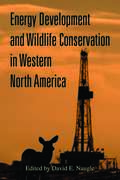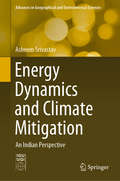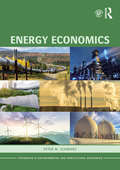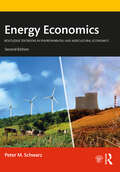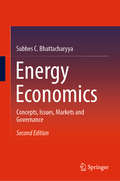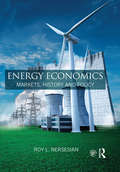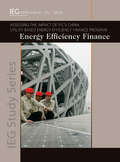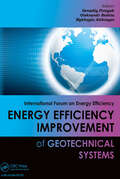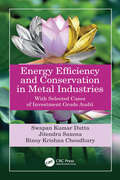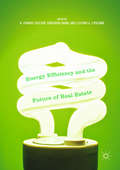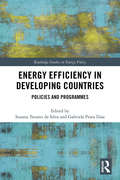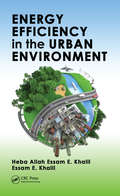- Table View
- List View
Energy & Ethics
by Benjamin K. SovacoolBenjamin K. Sovacool applies concepts from justice and ethics theory to contemporary energy problems, and illustrates particular solutions to those problems with examples and case studies from around the world.
Energy (Let's Explore Science)
by Tim CliffordExplores energy, how we use it, different yypes and forms, conservation and transformation of energy, renewable vs. non-renewable, and energy conservation.
Energy Accounts: Architectural Representations of Energy, Climate, and the Future
by Michael MannHow does one tell the story of energy production, use, or conservation in a manner sufficiently convincing to influence policy, behavior, and design? Energy Accounts explores potential answers to this question through compelling images, data visualizations, narratives, and other examples of accounting for energy. Organized into a collection containing both examples of best practices and critiques, this impressive array of projects and contributors combines text and graphic material to explore different representations of energy data. Including work from Kieran Timberlake, SHoP, AMO, Lateral Office, WOHA, and many more, the book boasts a unique graphic design which supports and enhances its role as a valuable resource for professionals and students in architecture, engineering, and urban design.
Energy Analysis for a Sustainable Future: Multi-Scale Integrated Analysis of Societal and Ecosystem Metabolism
by Mario Giampietro Kozo Mayumi Alevgül H. ŞormanThe vast majority of the countries of the world are now facing an imminent energy crisis, particularly the USA, China, India, Japan and EU countries, but also developing countries having to boost their economic growth precisely when more powerful economies will prevent them from using the limited supply of fossil energy. Despite this crisis, current protocols of energy accounting have been developed for dealing with fossil energy exclusively and are therefore not useful for the analysis of alternative energy sources. The first part of the book illustrates the weakness of existing analyses of energy problems: the science of energy was born and developed neglecting the issue of scale. The authors argue that it is necessary to adopt more complex protocols of accounting and analysis in order to generate robust energy scenarios and effective assessments of the quality of alternative energy sources. The second part of the book introduces the concept of energetic metabolism of modern societies and uses empirical results. The authors present an innovative approach – Multi-Scale Integrated Analysis of Societal and Ecosystem Metabolism (MuSIASEM) – capable of characterizing the quality of alternative energy sources in relation to both environmental constraints and socio-economic requirements. This method allows the metabolic pattern of a society to be described in relation to its feasibility, when looking at biophysical factors, and desirability, when looking at socio-economic factors.Addressing the issue of scale in energy analysis by cutting through the confusion found in current applications of energy analysis, this book should be of interest to researchers, students and policy makers in energy within a variety of disciplines.
Energy Audit and Management: Concept, Methodologies, Procedures, and Case Studies
by L. Ashok Kumar Gokul GanesanThis book describes the energy management concepts, energy audit principles, resource efficiency, and other energy conservation opportunities involved in different sectors across varied industries. Real-time case studies from various large industrial sectors, like cement, paper and pulp, refineries, manufacturing, garments and textile processing, power plants, and other MSME industrial sectors with cross functional energy conservation opportunities, are included. It also describes the future scope of energy auditing and management including IoT and data analytics. It also helps to gather the energy generated and utilization, energy conservation, and other process related data. Features: Provides entire coverage of energy management and audit concepts. Explores energy audit methodologies and energy saving initiatives. Incorporates current technologies like machine learning, IoT, data analytics in energy audit for reliability improvement. Includes case studies covering detailed energy saving calculation with investment pay back calculations. This book is aimed at researchers, professionals, and graduate students in electrical engineering, power systems, energy systems, and renewable energy.
Energy Cities (Green Energy and Technology)
by Dieter D. Genske Dagmar Everding Ariane RuffWith cities and regions moving away from fossil-nuclear energy sources, the importance of energy-ecological urban transformation is growing. A growing number of stakeholders are committed to transitioning energy supplies to renewable sources and promoting resource-efficient ecological cycles in their communities. Energy-ecological urban transformation directly improves living and environmental conditions in neighborhoods, creates new economic opportunities, and generates jobs. Cities are being transformed into 'energy cities' that adhere to the principles of sustainability, minimizing energy-ecological footprints, and reducing land consumption. This book envisions future scenarios of urban transformation for stakeholder discourse. It provides a cross-disciplinary description of urban planning, engineering, and economic approaches to energy-ecological urban transformation, including methodological solutions. Numerous interesting project examples are presented to illustrate these concepts. The target audience for this book includes municipal administrations and climate protection managers, planning and engineering firms, environmental organizations, as well as students and educators.
Energy Cooperation in South Asia: Utilizing Natural Resources for Peace and Sustainable Development (Routledge Explorations in Energy Studies)
by Mirza Sadaqat HudaThis book analyses the key political challenges to regional energy cooperation in South Asia. It argues that investment in the planning of regional energy projects can increase their viability and also drive integration and peacebuilding. Regional cooperation has been substantiated by academics and multilateral development banks as one of the most viable solutions to South Asia’s crippling energy crisis. However, three decades of national and regional efforts have failed to develop a single multilateral energy project or foster high levels of bilateral cooperation. Using data collected through extensive interviews with policymakers in India, Bangladesh, Pakistan and Nepal, this book identifies the specific roadblocks to energy cooperation – including domestic politics and the failure of leadership on multiple levels - and evaluates how these political challenges determine regional interactions on energy securitisation, environmental cooperation and human rights. Huda then undertakes case studies on four transnational energy projects to highlight specific policy recommendations to overcome these challenges, suggesting planning mechanisms through which the significant issue of energy cooperation in South Asia can be addressed. This book will be of great interest to students and scholars of energy security and geopolitics, natural resource governance and South Asian politics.
Energy Demand Challenges in Europe: Implications for policy, planning and practice
by Frances Fahy Gary Goggins Charlotte JensenThis open access book examines the role of citizens in sustainable energy transitions across Europe. It explores energy problem framing, policy approaches and practical responses to the challenge of securing clean, affordable and sustainable energy for all citizens, focusing on households as the main unit of analysis. The book revolves around ten contributions that each summarise national trends, socio-material characteristics, and policy responses to contemporary energy issues affecting householders in different countries, and provides good practice examples for designing and implementing sustainable energy initiatives. Prominent concerns include reducing carbon emissions, energy poverty, sustainable consumption, governance, practices, innovations and sustainable lifestyles. The opening and closing contributions consider European level energy policy, dominant and alternative problem framings and similarities and differences between European countries in relation to reducing household energy use. Overall, the book is a valuable resource for researchers, policy-makers, practitioners and others interested in sustainable energy perspectives.
Energy Democracy: Advancing Equity in Clean Energy Solutions
by Denise Fairchild Al Weinrub Diego Angarita Horowitz Isaac Baker Lynn Benander Strela Cervas Ben Delman Anthony Giancatarino Vivian Yi Huang Derrick Johnson Cecilia Martinez Michelle Mascarenhas-Swan Anya Schoolman Dr Sean Sweeney Maggie Tishman Miya YoshitaniThe near-unanimous consensus among climate scientists is that the massive burning of gas, oil, and coal is havingcataclysmic impacts on our atmosphere and climate. These climate and environmental impacts are particularly magnifiedand debilitating for low-income communities and communities of color.Energy democracy tenders a response and joins the environmental and climate movement with broader movements for social and economic change in this country and around the world.Energy Democracy brings together racial, cultural, and generational perspectives to show what an alternative, democratized energy future can look like. The book will inspire others to take up the struggle to build the energy democracy movement.
Energy Development and Wildlife Conservation in Western North America
by David E. NaugleEnergy Development and Wildlife Conservation in Western North America offers a road map for securing our energy future while safeguarding our wildlife heritage. Contributors show how science can help craft solutions to conflicts between wildlife and energy development by delineating core areas, identifying landscapes that support viable populations, and forecasting future development scenarios to aid in conservation design. The book calls for a shift away from site-level management that has failed to mitigate cumulative impacts on wildlife populations toward broad-scale planning and implementation of conservation in priority landscapes. It concludes by identifying ways that decision makers can remove roadblocks to conservation, and provides a blueprint for implementing conservation plans.
Energy Dynamics and Climate Mitigation: An Indian Perspective (Advances in Geographical and Environmental Sciences)
by Asheem SrivastavThis book analyzes the current approaches to energy management in India that is based on a carbon-intensive pathway, which if continued, may have serious implications for climate change mitigation with severe consequences for human health and survival. India, being a signatory to the United Nations Framework Convention on Climate Change (UNFCCC), the Kyoto Protocol, and the Paris Agreement, is committed to reducing greenhouse gas emissions; however, the country’s dilemmas are whether to prioritize environment over economy or vice versa and also whether economic growth can be sustained by relying on carbon-intensive development. Those are explored in this book. The Indian economy is poised for a big leap in the near future, and the topmost priority of the government is to ensure energy security, accessibility, and affordability for nearly 1.5 billion people. Currently, 70% of India’s electricity generation comes from coal- and oil-based thermal power plants, and only 12–15% of energy is generated from renewable sources. Experts are of the view that the demand for coal and gas power generation will continue to rise and is expected to reach the equivalent of nearly 2 billion t of oil by 2030. The annual consumption of natural gas is expected to increase fourfold to 200 billion m3 a year in the near future, and its share in the primary energy basket of coal, oil, and gas will rise from 6.5% to 15% by 2030. This will not only cause a significant drain on foreign reserves but will also pose an enormous challenge to policymakers and scientists. This book serves as a useful guide in shaping India’s future energy policy.
Energy Economics (Routledge Textbooks in Environmental and Agricultural Economics)
by Peter M. SchwarzWith interest in topics such as climate change, energy security, and alternative energy sources being at an all-time high, the effects of today's decisions now rest on the shoulders of future generations. There are no easy answers to our energy issues, so costs and benefits must be considered when evaluating all energy alternatives; alongside that, prices must be right and need to reflect the full social costs to society of a given source of energy. Energy Economics outlines the fundamental issues and possible solutions to the challenges of energy production and use, and presents a framework for energy decisions based upon sound economic analysis. It considers market forces and policy goals, including economic prosperity, environmental protection, and other considerations that affect societal well-being. This book focuses on both energy choices and the impact of these choices on market performance, environmental conditions, and sustainability. The initial section covers the fundamental economic concepts for analyzing energy markets. Following this, a detailed analysis of established energy sources, specifically fossil fuels and nuclear energy, leads into consideration of energy alternatives such as renewable energy and next-generation alternatives. Electricity production and regulatory trends are covered in depth. The final section considers policy: environmental considerations, sustainability, and energy security. The concluding chapter is a comprehensive vision for our energy future. Drawing on current energy headlines, perspectives familiar from the popular press, and views outside economics, this text sharpens students' ability to understand, evaluate, and critique policy using appropriate economic analysis. The text builds a foundation that culminates in a view of a comprehensive energy policy that improves upon the vacillations of past decades.
Energy Economics (Routledge Textbooks in Environmental and Agricultural Economics)
by Peter M. SchwarzEnergy Economics outlines the fundamental issues and possible solutions to the challenges of energy production and use, presenting a framework for decisions based upon sound economic analysis. This approach considers market forces and policy goals, including economic prosperity, environmental protection, and societal well-being. The second edition has been thoroughly updated, addressing dramatic shifts in the use of fuel and electricity, accelerated plans for the use of renewable energy, and pathways towards a lower-carbon future. A new chapter on electric vehicles examines its impact on transportation, the electricity market, and carbon emissions. Global examples throughout the book reflect the universal application of energy economics. With this economic foundation, coupled with perspectives from real-world applications, and perspectives from related disciplines, this text sharpens the student’s ability to understand, evaluate, and critique energy policy. A companion website provides reinforcement for students through multiple choice self-test quizzes and homework exercises, as well as additional materials for instructors. This textbook should be essential reading for students of energy economics, environmental and natural resource economics, energy-related disciplines, and general readers seeking to expand their knowledge of energy economics and policy.
Energy Economics: Concepts, Issues, Markets and Governance
by Subhes C. BhattacharyyaThis book provides an updated and expanded overview of basic concepts of energy economics and explains how simple economic tools can be used to analyse contemporary energy issues in the light of recent developments, such as the Paris Agreement, the UN Sustainable Development Goals and new technological developments in the production and use of energy. The new edition is divided into four parts covering concepts, issues, markets, and governance. Although the content has been thoroughly revised and rationalised to reflect the current state of knowledge, it retains the main features of the first edition, namely accessibility, research-informed presentation, and extensive use of charts, tables and worked examples.This easily accessible reference book allows readers to gain the skills required to understand and analyse complex energy issues from an economic perspective. It is a valuable resource for students and researchers in the field of energy economics, as well as interested readers with an interdisciplinary background.
Energy Economics: Markets, History and Policy
by Roy L. NersesianThree quarters of our current electricity usage and transport methods are derived from fossil fuels and yet within two centuries these resources will dry up. Energy Economics covers the role of each fossil and renewable energy source in today’s world, providing the information and tools that will enable students to understand the finite nature of fossil fuels and the alternative solutions that are available. This textbook provides detailed examinations of key energy sources – both fossil fuels and renewables including oil, coal, solar, and wind power – and summarises how the current economics of energy evolved. Subsequent chapters explore issues around policy, technology and the possible future for each type of energy. In addition to this, readers are introduced to controversial topics including fracking and global warming in dedicated chapters on climate change and sustainability. Each chapter concludes with a series of tasks, providing example problems and projects in order to further explore the proposed issues. An accompanying companion website contains extensive additional material on the history of the major types of fuel as well as technical material relating to oil exploration, the development of solar power and historical environmental legislation. This textbook is an essential text for those who study energy economics, resource economics or energy policy.
Energy Efficiency Applications in Buildings: Volume 1: Theories, Methods, and Tools
by Wei Shi Bertug Ozarisoy Hasim Altan Young Ki KimEnergy Efficiency Applications in Buildings presents an investigation into the energy use and measures to improve the energy efficiency of existing building stock in the UK. The aim of this research is to assess the domestic energy use of statistically representative residential buildings and their occupants’ thermal comfort by considering the significant impact of overheating risks on energy consumption and occupants’ well-being.Divided into two volumes, these books present energy consumption and thermal comfort in the construction sector as a complex socio-technical problem that involves the analysis of an intrinsic interrelationship amongst dwellings, occupants, and the environment. Using case studies, the authors demonstrate the significance of improving energy efficiency and its impact on occupants during long-term heatwaves in the summer. Additionally, the volumes demonstrate how dynamic thermal energy simulation can be used as a learning laboratory for future trends in housing energy consumption reduction.Volume 1: Theories, Methods, and Tools presents the background to the research and the assessment methods and tools adopted by the research team.Volume 2: Performance Evaluation and Retrofitting Strategies describes the case studies and building performance and post-occupancy evaluations, before making strategic policy and retrofitting recommendations.The research and roadmap presented in these volumes can be used as a guidance tool for building energy modelling and performance simulation, enabling architects, building engineers, and other practitioners to close the gap between the current understanding and the actual performance of existing building stocks.
Energy Efficiency Finance: Assessing the Impact of IFC's China Utility-based Energy Efficiency Finance Program
by World BankThis evaluation assesses the performance of IFC's energy efficiency finance program in China aimed at stimulating energy efficiency investments through bank guarantees and technical assistance. The difference made by the program is traced along the chain of interventions: (i) at the level of banks, the program is narrowly based on one of the two partner banks, which, with the help of the program, expanded its energy efficiency lending as a new business line; (ii) at the level of energy management companies, the program's technical assistance improved the program participants' access to finance; and (iii) at the end-user level, it promoted the use of energy efficiency investments that achieved reduction of greenhouse gas emissions. The utilization of IFC's program has been rapid compared with other similar programs. The energy efficiency investments supported by the program have reduced greenhouse gas emissions by 14 million CO2 tons per year, slightly in excess of the target set at the beginning of the program. However, there is only a weak differentiation in behavior surrounding energy efficiency investment between end users supported by the program and other similar companies that were not. It is important to note that the performance of the program was heavily influenced by the government's policy actions and the earlier efforts of other players: The Chinese government and other players such as the World Bank. The CHUEE program, relying mainly on commercial funding through IFC's guarantees, builds on these efforts
Energy Efficiency Improvement of Geotechnical Systems: International Forum on Energy Efficiency
by Genadiy Pivnyak Mykhaylo Alekseyev Oleksandr BeshtaThis book covers innovative technologies and approaches for improvement of technical and economic parameters of functional geotechnical systems. The focus is on mathematical modelling of objects and processes, as well as the development of techniques and their control algorithms. The book comprises schemata of practical tasks solving related to min
Energy Efficiency and Conservation in Metal Industries: With Selected Cases of Investment Grade Audit
by Swapan Kumar Dutta Jitendra Saxena Binoy Krishna ChoudhuryThis book provides a deep insight into the energy usage in the energy intensive metal industry and the methodology for efficiency assessment. Various methodologies for energy audits are described, along with concept-level analysis for minimum energy design. Apart from the technical and engineering analysis, the book also describes management aspects such as energy management systems and financial, environmental and social analysis leading to the development of a comprehensive plan for implementation of energy efficiency and conservation in industries. Barriers to investment in energy efficiency and conservation are discussed, based on review of global and Indian case studies. FEATURES: Details fundamental principles driving energy consumption in an industrial set-up backed with illustrative examples Explains various alternative methods for discovery of energy efficiency and conservation projects. Focusses on metal-producing and -processing facilities with an emphasis on environmental quality Supports maximum digitalization of energy audit assessment and report preparation processes Includes global case studies and tutorials at the end of the corresponding chapters This book is useful for researchers, professionals and graduate students in thermodynamics, manufacturing, thermal engineering, energy engineering, energy efficiency and energy processes, especially in the metal industry.
Energy Efficiency and the Future of Real Estate
by Yongsheng Wang N. Edward Coulson Clifford A. LipscombThis book explores how energy efficiency is a major component in the development of sustainable real estate. Efficiency is one of the most frequently-mentioned aspects of government policies for green building design in the United States and around the world. There has been a significant amount of effort devoted to the creation of green practices in real estate, including building construction, building assessment, city planning, investment, governmental regulation and policies, and industrial development. One of the key emphases of the above activities is energy efficiency, thus it is crucial for researchers and readers to have a comprehensive overview of the topic, as this book provides.
Energy Efficiency in Developing Countries: Policies and Programmes (Routledge Studies in Energy Policy)
by Suzana Tavares Da Silva Gabriela Prata DiasThis book presents a comparative analysis of energy efficiency policies in developing countries. Although there is a vast amount of literature available about renewable energy policy and implementation in the developing world, energy efficiency tends to lack attention. This book fills this lacuna by examining the current state of the field and scope for future improvements. Drawing on a wide range of case studies including Brazil, China and Chile, the authors use a comparative approach to examine the policies and programmes being implemented, looking at the existing legal frameworks and regulatory challenges. By showcasing stories of success, as well as barriers to energy efficiency, they highlight the opportunities for increased energy access and efficiency and demonstrate how these opportunities may directly impact on climate change mitigation. This volume will be a useful resource for scholars and practitioners with an interest in energy policy and efficiency, climate change and international development.
Energy Efficiency in the Urban Environment
by Heba Allah Khalil Essam E. KhalilEnergy Efficiency in the Urban Environment is a study of energy crisis, urbanisation, and climate change, as well as a discussion of how to combat these global challenges. With a special focus on Egypt, this book addresses the macroscale of urbanism from the perspective of city dwellers' quality of life, and explores the microscale of buildings and
Energy Efficiency: Building a Clean, Secure Economy
by James L. SweeneyThe entire world, especially the United States, is in the midst of an energy revolution. Since the oil embargo of 1973, individuals, corporations, and other organizations have found ways to economically reduce energy use. In this book, Jim Sweeney examines the energy policies and practices of the past forty years and their impact on three crucial systems: the economy, the environment, and national security. He shows how energy-efficiency contributions to the country's overall energy situation have been more powerful than all the increases in the domestic production of oil, gas, coal, geothermal energy, nuclear power, solar power, wind power, and biofuels. The author details the impact of new and improved energy-efficient technologies, the environmental and national security benefits of energy efficiency, ways to amplify energy efficiency, and more. Energy Efficiency: Building a Clean, Secure Economy reveals how the careful nurturing of private- and public-sector energy efficiency--along with public awareness, appropriate pricing, appropriate policies--and increased research and development, the trends of decreasing energy intensity and increasing energy efficiency can be beneficially accelerated.
Energy Efficient Affordable Housing: Policy Design and Implementation in Canadian Cities
by Sasha TsenkovaThis book provides the first comparative assessment of the energy-efficiency retrofit programs in the social housing sector of Canadian cities, focusing on program efficiency and effectiveness. The analytical framework explores key policy instruments - regulatory, fiscal and institutional - in relation to major results achieved. The approach is interdisciplinary, supported by rich empirical data from case studies, observations and interviews. The book explores important strategies for the provision of green and affordable housing, while addressing climate change imperatives and resilience issues. This is of great interest to researchers, policy makers, city leaders, professionals and students. Its value added contribution to scholarship is complemented by practical relevance for social housing organisations in countries with a small residual housing sector. It offers valuable lessons for the design, planning and implementation of energy retrofit programs in North America and beyond.
Energy Efficient Building Design
by Ana-Maria DabijaThis book is the result of recent research that deals with the built environment and innovative materials, carried out by specialists working in universities and centers of research in different professional fields ─ architecture, engineering, physics ─ and in an area that that spans from the Mediterranean Sea to the Persian Gulf, and from South Eastern Europe to the Middle East. This book takes the necessity of re-shaping the concept of building design in order to transform buildings from large scale energy consumers to energy savers and producers into consideration. The book is organized in two parts: theory and case studies. For the theoretical part, we chose from the wide range of sources that provide energy efficient materials and systems the two that seem to be endless: the sun and vegetation. Their use in building products represents a tool for specialists in the architectural design concept. The case-studies presented analyze different architectural programs, in different climates, from new buildings to rehabilitation approaches and from residential architecture to hospitals and sports arenas; each case emphasizes the interdisciplinarity of the building design activity in order to help readers gain a better understanding of the complex approach needed for energy efficient building design
